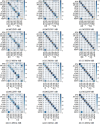A complex-valued convolutional fusion-type multi-stream spatiotemporal network for automatic modulation classification
- PMID: 39333244
- PMCID: PMC11436720
- DOI: 10.1038/s41598-024-73547-w
A complex-valued convolutional fusion-type multi-stream spatiotemporal network for automatic modulation classification
Abstract
Automatic Modulation Classification (AMC) is crucial in non-cooperative communication systems as it facilitates the identification of interference signals with minimal prior knowledge. Although there have been significant advancements in Deep Learning (DL) within the field of AMC, leveraging the inherent relationships between In-phase (I) and Quadrature-phase (Q) components, and enhance recognition accuracy under low signal-to-noise ratio (SNR) conditions remains a challenge. This study introduces a complex-valued convolutional fusion-type multi-stream spatiotemporal network (CC-MSNet) for AMC, which combines spatial and temporal feature extraction modules for modulation recognition. Experimental results demonstrate that the CC-MSNet performs well on three benchmark datasets, RML2016.10a, RML2016.10b, and RML2016.04c, with average recognition accuracy of 62.86%, 65.08%, and 71.12%. It also performs excellently in low SNR environments below 0dB, significantly outperforming other networks.
© 2024. The Author(s).
Conflict of interest statement
The authors declare no competing interests.
Figures















References
-
- Guo, K., Dong, C. & An, K.NOMA-based cognitive satellite terrestrial relay network: secrecy performance under channel estimation errors and hardware impairments.IEEE Internet Things J.9(18), 17334–17347. 10.1109/JIOT.2022.3157673 (2022).
-
- Guo, K., Li, X., Alazab, M., Jhaveri, R. H. & An, K. Integrated satellite multiple two-way relay networks: secrecy performance under multiple eves and vehicles with non-ideal hardware. IEEE Trans. Intell. Veh.10.1109/TIV.2022.3215011 (2022).
-
- O’Shea, T. J., Corgan, J. & Clancy, T. C. Convolutional radio modulation recognition networks. In Engineering Applications of Neural Networks: 17th International Conference, EANN, Aberdeen, UK, September 2–5, 2016, Proceedings 17, 213–226 10.1007/978-3-319-44188-7_16 (Springer, 2016).
-
- West, N. E. & O’shea, T. Deep architectures for modulation recognition. In 2017 IEEE International Symposium on Dynamic Spectrum Access Networks (Dy SPAN), Piscataway, NJ, 2017, 1–6. 10.1109/DySPAN.2017.7920754 (2017).
-
- O’Shea, T. J., Roy, T. & Clancy, T. C. Over-the-air deep learning based radio signal classification. IEEE J. Sel. Top. Signal Process.12, 168–179. 10.1109/JSTSP.2018.2797022 (2018).
Grants and funding
LinkOut - more resources
Full Text Sources

